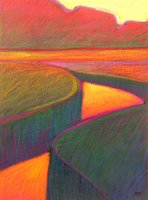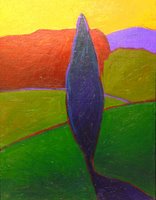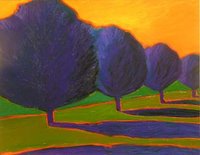The Value of Art

In our American culture when schools are suffering economic hardship the arts are the first programs to be cut. Why? Obviously, society sees the arts as having little value. Is this really true or are our leaders and politicians mistaken? I believe they are wrong but go figure, I’m an artist, and what am I going to think?
In reality, I have seen many articles over the last couple of decades that speak to the importance of having the arts as part of the core curriculum. Studies have shown that when music and art are included, math and science scores go up. . Years ago, elementary school teachers found that if they softly played Mozart in the background, students learned arithmetic more quickly and retained what they learned. What was it about art and music that caused this to happen?
We know that the two halves of the brain have different functions. The left side is the logical side and this controls math, science, and language. The right side is the intuitive side. This is where art and music like to hang out. The left side is the dominant side and just can’t stand not being in control. When I teach drawing, I give students exercises that help them to turn off the left side of the brain. Actually it teaches them how to frustrate the left side and cause it to give up control to the right side. What is happening in the brain is more important than just the fluff stuff that most people see as being art. The person moves closer to being a whole brain thinker and effectively using more of the brain. The brain becomes more creative in solving problems. When Albert Einstein would be having difficulty with an equation, he would sit in a corner and play his violin. In the darkest days of WWII, Sir Winston Churchill would sit out in his garden and paint landscapes.
Our earliest ancestors, while still living in caves, made art well before they developed a written language. Even today children with learning disabilities, such as dyslexia, are taught rhythm, movement, and song to help them to learn and understand. Children are still taught the alphabet by learning a song, the infamous alphabet song. Rituals and story telling were used for millenniums to help cultures to learn and understand their histories. Yet today, our culture persists in devaluing the arts, unless of course you are a rich and famous artist, musician, actor, or whatever. As the old saying goes, “Money talks and bullshit walks.” So does art really talk?
Years ago I gave a series of talks to civic organizations on the value of art the need for the community to foster the growth of the arts. I approached it from an economic point of view. One of my favorite examples was the difference between East and West Berlin (if you are post Reagan-Gorbechev you may not remember this). East Berlin was very oppressive to the arts (art, music, literature, theater, etc.) and the city was very gray and lifeless. It struggled economically. On just the other side of the Berlin Wall, West Berlin encouraged and embraced the arts. The city was colorful and alive and the citizens of the city embraced creativity. The result was a city that was innovative and had a healthy and robust economy. What causes this difference?
What happens is something that is very dangerous and it causes world governments to shake and tremble with fear. The arts encourage people to see things in new and different ways. People and things are no longer taken for granted. New possibilities arise. In other words, people learn how to think not what to think. Knowing how to think (and solve problems) gives true power to every person. Thomas Jefferson once said that an educated population could govern itself.
An accidental footnote. My van has been sold as scrap, it was beyond repair. The young man who caused the accident ran the stop sign because he was playing with his iPod. After a few days of ranting and raving, I have gone through my grieving process and moved on. I survived a deadly crash and did not even have a scratch on me. Amazingly I did not have a single bruise nor even suffer a stiff or sore muscle. My life has been changed by not having a vehicle but change is a good thing.
The above painting is an oil pastel on sealed and primed Strathmore paper. The title is “Stream Through The Tall Grasses Version 03”. It measures 14.625” X 10.25” and was completed in 2005.




